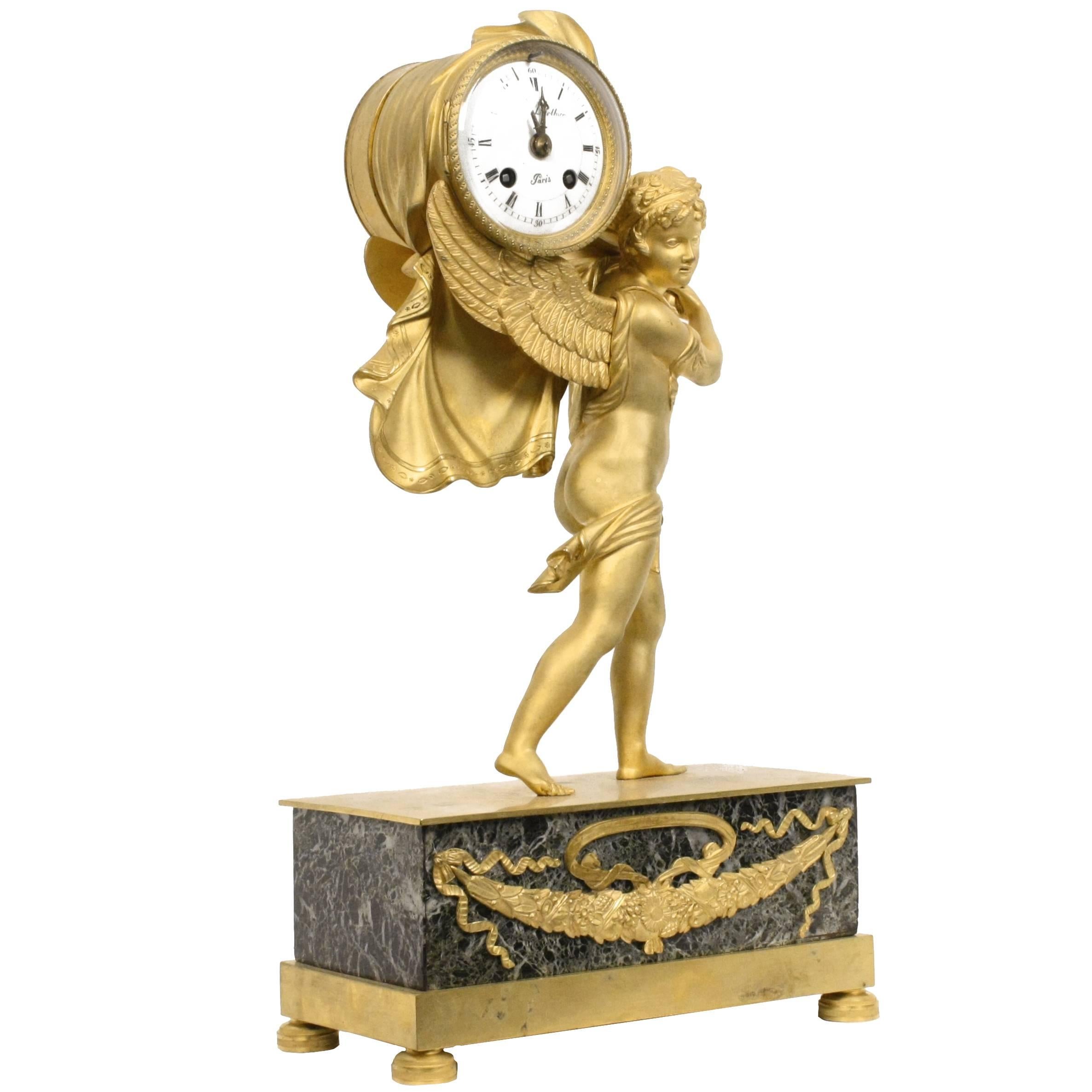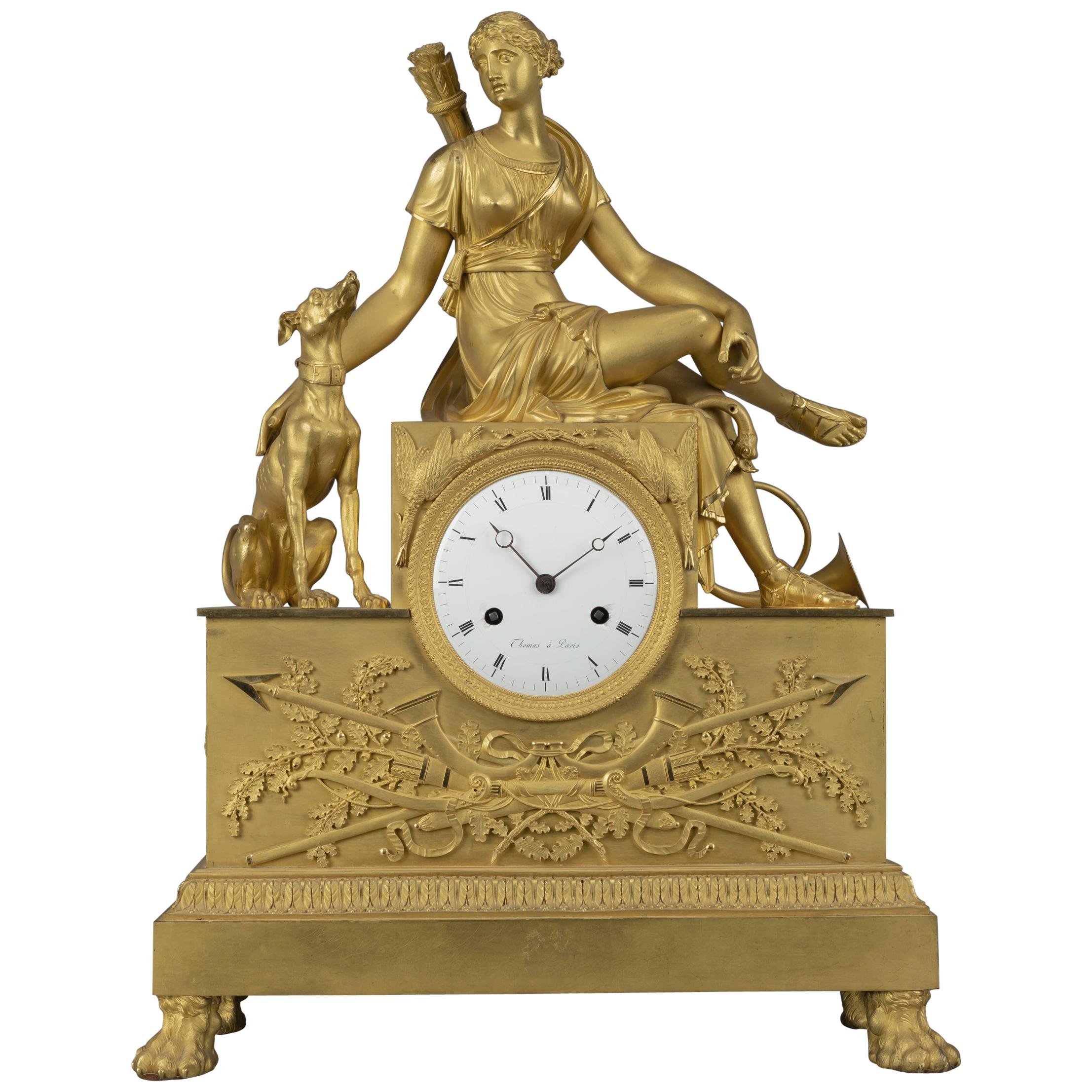Items Similar to French Empire Figural Bronze Clock Depicting an Allegory to Prudence or Wisdom
Video Loading
Want more images or videos?
Request additional images or videos from the seller
1 of 22
French Empire Figural Bronze Clock Depicting an Allegory to Prudence or Wisdom
About the Item
A rare model of a French Empire mantle clock depicting an allegory to "La Prudenzia" or Prudence, Wisdom or Sound Judgement. This virtue is represented as a patinated bronze statue of of a classically draped bearded standing male figure leaning on a gilt bronze plinth legs crossed and with a sword in its scabbard by his side. There is an an open scroll on top of the plinth held in place by the figure's elbow arm raised and forefinger of his hand pointing at his temple in a gesture associated with thinking. The plinth housing the clock dial and movement is decorated with a serpent coiled around a rod which along with the sword and scroll are associated with "La Prudenzia".
The whole sits on a gilded rectangular base decorated with a finely cast frieze centred by a rondel showing the two Janus heads. In ancient Roman religion and myth, Janus is the god of beginnings, transitions, and endings. He is often depicted as having two faces, one looking to the future and one to the past.
The clock dial features a silvered chapter ring, the twin barrel movement with its original silk-string suspension movement rings the hours and halves on a bell.
An identical model of this clock is found in the Spanish Royal Collection. Refer to images.
Addendum: Its intended allegory to "La Prudenzia" apart, the imagery of this particular clock could easily be adapted to represent the apostle Saint Paul specifically in his role as the patron saint of the Mediterranean Island of Malta. The imposing intense looking tall bearded figure plus sword the scroll are all characteristics of how St Paul is often depicted in paintings. However, the symbol that could ostensibly represent the link to Malta is the snake coiled around a rod mounted on the face of the plinth housing the clock dial and movement,
The apostle Paul's time in Malta is described in the Book of Acts (Acts 27:39–42; Acts 28:1–11). Saint Paul was shipwrecked in what is believed to be Malta in the year 60 AD, on his way to trial and eventual martyrdom in Rome. Legend has it that while gathering firewood for warmth, he was bitten by a venomous viper. The people there expected him to swell up and die rather quickly. When he was unaffected by the bite, the population assumed he was a god. While recovering from the effects of the shipwreck and waiting to continue his journey to Rome, St Paul proceeded to convert the Maltese who were at the time pagan under the Roman rule, to Christianity. The viper, the sword and scroll or often a book are the three symbols collectively associated with St Paul as the Patron Saint of Malta.
- Dimensions:Height: 25 in (63.5 cm)Width: 15.5 in (39.37 cm)Depth: 6.5 in (16.51 cm)
- Style:Empire (Of the Period)
- Materials and Techniques:
- Place of Origin:
- Period:
- Date of Manufacture:circa 1805
- Condition:Wear consistent with age and use.
- Seller Location:Vancouver, CA
- Reference Number:1stDibs: LU4631215944331
About the Seller
4.9
Vetted Seller
These experienced sellers undergo a comprehensive evaluation by our team of in-house experts.
Established in 1981
1stDibs seller since 2019
139 sales on 1stDibs
Typical response time: 3 hours
- ShippingRetrieving quote...Ships From: Vancouver, Canada
- Return PolicyThis item cannot be returned.
More From This SellerView All
- French Empire Gilt Bronze Allegorical Clock Depicting the Astronomical SciencesLocated in Vancouver, British ColumbiaA fine early 19th century French Empire gilt bronze clock representing an allegory of astronomy; featuring two classically draped maide...Category
Antique Early 19th Century French Empire Mantel Clocks
MaterialsBronze
- French Empire Gilt Bronze Clock Depicting the Lydian Queen OmphaleLocated in Vancouver, British ColumbiaAn early 19 century French Empire gilt bronze clock depicting the mythological Lydian Queen Omphale sitting astride on a draped drum th...Category
Antique Early 19th Century French Empire Mantel Clocks
MaterialsBronze
- Allegorical French Empire Gilt Bronze Clock Depicting Earth’s Source of WaterLocated in Vancouver, British ColumbiaA gilt bronze French Empire clock depicting an allegory to the earth’s water source. In this clock a classically draped nymph sits atop a rocky outcrop her right foot resting on the ...Category
Antique Early 19th Century French Empire Mantel Clocks
MaterialsBronze
- French Empire Bronze Clock Depicting Urania Greek Muse of AstronomyBy LesieurLocated in Vancouver, British ColumbiaA magnificent large gilded and patinated bronze period French Empire mantle clock depicting Urania the Greek Muse of Astronomy standing on a stepped rectangular gilded bronze base h...Category
Antique Early 19th Century French Empire Mantel Clocks
MaterialsBronze
- French Empire Allegorical Clock Depicting Roman Triumph and PowerLocated in Vancouver, British ColumbiaA figural gilt bronze French Empire clock, ‘Allegory to Triumph and Power’. A Roman emperor stands to the right of the central rectangular plinth housing the movement; atop the plint...Category
Antique Early 19th Century French Empire Mantel Clocks
MaterialsBronze
- French Empire Clock Depicting Psyche Playing with a Butterfly After CanovaLocated in Vancouver, British ColumbiaA French Empire Clock depicting Psyche playing with a butterfly after a marble statue by Canova displayed in the Louvre. A patinated bronze Psych...Category
Antique Early 19th Century French Empire Mantel Clocks
MaterialsBronze
You May Also Like
- French Bronze Figural Clock Depicting AuroraLocated in Norwich, GBFrench Bronze figural clock with a finely cast Bronze statue depicting Aurora holding a brass Orb clock with Roman numerals and original moonpoise hands. ...Category
Antique 1870s French Mantel Clocks
MaterialsBronze
- French Empire Figural Gilt Bronze Mantel ClockLocated in New York, NYWinged cupid with flowing robe, clock resting between wings and fabric, raised on bronze ormolu-mounted verde antico plinth. France, first half of the 19th century. Measures: H ...Category
Antique 19th Century French Empire Mantel Clocks
MaterialsMarble, Bronze, Enamel
- Empire Gilt-Bronze Clock Depicting Diana the Huntress. French, c 1820Located in Brighton, West SussexA fine Empire Period gilt bronze clock depicting Diana the huntress. The dial signed 'Thomas a Paris'. The white enamel dial with Roman numerals and Breguet hands, the case sur...Category
Antique Early 19th Century French Empire Mantel Clocks
MaterialsBronze
- Antique French Empire Neoclassical Gilt Bronze Figural ClockLocated in New York, NYAn Exquisite Antique French Period Empire Neoclassical gilt bronze figural clock embellished with figure of a neoclassical woman and bird.Category
Antique 19th Century French Empire Clocks
MaterialsOrmolu, Steel, Enamel
- Empire Ormolu and Patinated Bronze Figural ClockLocated in Kittery Point, MEIn the form of a putto with a wheel barrow carrying a keg mounted with a clock face topped by a crane, on a rectangular chased plinth ending in bun feet.Category
Antique Early 19th Century French Empire Table Clocks and Desk Clocks
MaterialsBronze
- French Empire Gilt Bronze ClockLocated in London, GBFrench Empire gilt bronze clock French, early 19th century Measures: Height 38cm, width 27cm, depth 10cm This fine gilt bronze man...Category
Antique Early 19th Century French Empire Mantel Clocks
MaterialsBronze, Ormolu
Recently Viewed
View AllMore Ways To Browse
Clock Dial
Greek 19th
19th Century Greece
Used Drapes
French Drapes
Antique Drapes
Greek Classical Furniture
Antique French Drapes
French Gold Clock 19th Century
Classical Greek Circa
Greek French Bronze
Ancient Empires
Spanish Royal
Greek Symbol
Classical Plinth
Greek Royal
Greek Gold Decorative Object
Antique Gold Drapes





